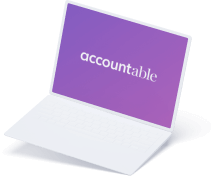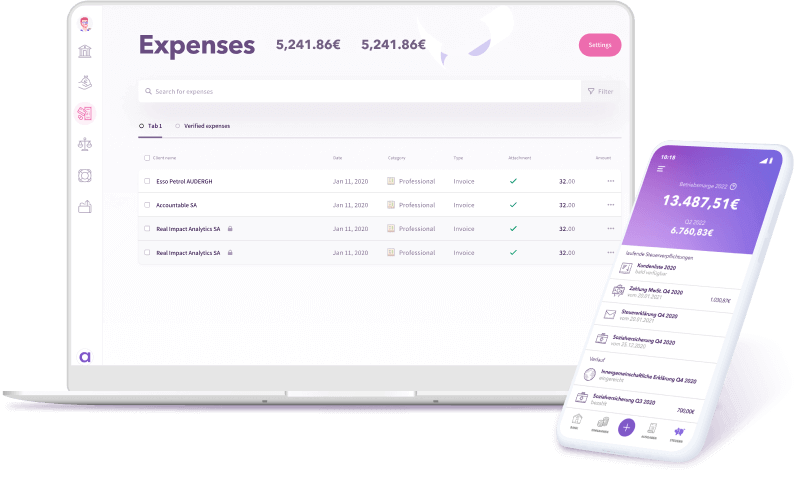
An overview of the different tax classes
Read in 7 minutes
How much income tax is deducted from your income is largely determined by your tax class. There are seven tax brackets in Germany. Which one you end up in depends on your personal circumstances. What about tax classes for self-employed individuals (Selbständige)?
We’ll give you an overview of the different income tax classes in Germany so you have a better idea of why you may be in a certain tax class, in which situations you can change your tax class and when it makes sense to do so.
The seven tax classes: Which one am I actually in?
In Germany, there are seven income tax brackets, which are commonly referred to as tax classes. The tax class you’re in depends on your marital status. Your profession does not play a role. Your tax class determines how much income tax you pay.
💡But beware, as a self-employed person, you are not subject to Lohnsteuer (wage/salary tax). Unlike wage and salaried employees, income tax isn’t taken out of your monthly income. Instead, you pay your income tax (Einkommensteuer) directly to the tax office. This means you don’t have an income tax bracket.
The topic of salary/wage taxes (Lohnsteuer) is only relevant for you as a self-employed person if you are married and your partner works as an employee somewhere or if in addition to the work you do on a self-employed basis, you are also employed by someone else. In this case, taxes will be taken out of your wages/salary for the job you do as an employee, and you are also responsible for paying income tax on the work you do as a freelancer. Here is an overview of the income tax classes.
Tax classes for unmarried individuals
Since tax classes are assigned according to marital status, a basic distinction can be made between people who are married or living in a registered partnership and those who are not. For the latter, tax classes 1 and 2 apply.
Tax class 1: Single
Tax class 1 is for people who are considered single according to tax law. You are considered single (alleinstehend) if you are
- single,
- separated,
- divorced
- or widowed
This means that if you live with another person as a couple, but you aren’t married and haven’t registered a civil partnership, you are still classified as single, separated, divorced or widowed for income tax class purposes.
This is the case even if you live together as a couple or have children together. If you are not married or do not have a registered civil partnership, you will usually find yourself in tax class 1.
Tax class 2: Single parents
If you are a single parent, you can switch to tax class 2. The advantage of switching to this tax class is that it entitles you to a relief amount (Entlastungsbetrag) of €4,260 (for 2023) per year.
For each additional child, the amount increases by €240 per child. A single parent is someone who lives alone on a permanent basis and has at least one child in the household. In addition, you must be eligible to receive child benefit (Kindergeld) for your children.
Tax classes for married couples and registered civil partnerships
If you are married or living in a registered partnership, you can be in tax class 3, 4, 4 with factor or 5. If you have trouble remembering which tax classes can go together, just remember that the sum of the tax classes for both partners always equals 8.
Tax class 4: The standard case
If you marry or enter into a civil partnership, both you and your partner will automatically be placed in tax class 4. If you would like to change to a different income tax class, you must apply to do so.
To change tax classes, both you and your partner must live in Germany. If you apply to change tax classes in the year that you get married, the change can be applied retroactively, starting from the month you got married.
💡Accountable tip: As a couple, you can also file a joint tax return if one person is self-employed, and the other person works for an employer. You can find out more about this in our guide.
Tax classes 3 and 5: For couples with a significant difference in incomes
Combining tax classes 3 and 5 is particularly worthwhile for married couples and civil partnerships if there is a significant difference in the two incomes. The person with the higher income then switches to tax class 3, while the person with the lower income switches to tax class 5.
The basic tax-free allowance (Grundfreibetrag) and the child tax-free allowance (Kinderfreibetrag) are transferred from the person with the lower income to the partner with the higher income. This means that less income tax is due per month for the person with the higher income, leaving more net income per month.
Those who choose the 3/5 tax class combination are required to file a joint tax return every year.
The disadvantage is that the person who is in tax class 5 will have significantly less net left over than if they were taxed individually. This may affect the amount of money received for other benefits as well. Benefits that can be affected by this change in tax class are:
- Unemployment benefit (Arbeitslosengeld I)
- Short-time work benefit (Kurzarbeitergeld)
- Maintenance allowance/alimony (Unterhaltsgeld)
- Sickness benefit (Krankengeld)
- Injury allowance (Verletztengeld)
- Transitional allowance (Übergangsgeld)
- Sickness benefit for members of the military (Versorgungskrankengeld)
- Parental allowance or maternity allowance (Eltern- oder Mutterschaftsgeld)
In order to avoid both partners being unfairly taxed, the income tax class 4 with factor was introduced. Another disadvantage of the 3/5 combination is that taxes often have to be paid back at the end of the year.
Tax class 4 with factor: Fair taxation of different income levels
The different levels of a couple’s income are taken into account when it comes to tax class 4 with factor, just as in the 3/5 combination. The big difference, however, is that the person with the higher income also bears the higher tax burden. This results in the person with the lower income having more net left at the end of the month.
The tax office calculates an individual factor, which is applied to the couple’s income tax. Although you pay more income tax each month than you would with the 3/5 combination, the individual factor means that there are hardly any additional payments at the end of the year. With this option, you are also required to file a tax return.
Example calculation: Comparison of income tax classes 4, 3/5 and 4 with factor
The choice of tax class has no influence on the amount of income tax you pay per year as a couple. It only affects how much net you have left over at the end of the month. On the other hand, some tax classes require you to pay more later on, because the tax burden is merely distributed differently.
We’ll show you an example calculation to make this clearer. The example refers to the tax year 2022. Partner A has an income of €40,000 and Partner B earns €20,000.
As you can see, the total amount of income tax paid is the same for all combinations. Only the monthly amount for income tax and the tax refund or back payment differ significantly.
| Tax class | Income tax partner A with €40,000 income | Income tax partner B with €20,000 income | Total income tax | Refund / back payment (-) | Total income tax paid |
| 4/4 | €5,507 | €941 | €6,448 | €284 | €6,164 |
| 3/5 | €2,214 | €3,093 | €5,307 | – €857 | €6,164 |
| 4/4 with factor | €5,259 | €898 | €6,157 | – €7 | €6,164 |
💡Accountable tip: According to the traffic light coalition agreement, plans have been made to abolish income tax classes 3 and 5. Married couples and partners would then only be able to choose between income tax classes 4 and 4 with factor. This is intended to make the tax burden on partners fairer, as each partner will only have to pay the portion of income tax that corresponds to their salary. July 1, 2023 was supposed to be the date for the abolition of income tax classes 3 and 5, but the change did not take place.
Tax class 6: More than one job
If you have a second job in addition to your main job and the second job is also subject to social security contributions, you also qualify for tax class 6. This means that you are in two tax classes.
One of the tax classes 1-5 is normally applied to the income generated from your main job. Which tax class you are in for you main source of income depends on your marital status. Tax class 6 applies to the income from your part-time job.
In tax class 6, there is no tax-free allowance (Freibetrag) and you have to pay tax on your entire income. The tax burden is therefore particularly high in this case. You can decide yourself which job counts as your main job and which one as your secondary source of income. It makes the most sense to choose the job with the higher income as your main one, because less tax has to be paid in income tax classes 1-5. You have to inform your employer about the tax class, and filing a tax return is mandatory.
No tax has to be paid on secondary jobs that are not subject to social security contributions. Tax class 6 is therefore not relevant for such jobs. For example, this applies to mini jobs.
How do I change my tax class?
You tax class can change automatically or after submitting an application in instances where your personal situation changes. If you get married, your tax class changes automatically. If you then want to change to tax class 3/5 or 4 with factor, you need to submit an application.
In the event of a divorce, the income tax class changes again. Both partners then return to tax class 1 or 2. However, following a divorce, you need to submit an application as the change does not take place automatically. The tax class does not have to be changed at the time of the divorce. Couples who are permanently separated but not divorced can change their tax class on January 1 of the following year.
If you are a single parent when your child is born, you can change to income tax class 2. You must apply for this change at your local tax office (Finanzamt). You can submit the application directly after the birth of your child and benefit from the higher relief amount (Entlastungsbetrag).
Since 2020, it is now possible to change your tax class several times a year. And since October 2021, you can even do it online. To ensure that a tax class change is still taken into account for the current tax year, you must apply for it by November 30 at the latest.
Summary: Tax classes for the self-employed
To summarise, self-employed individuals (Selbstständige) don’t really need to worry about tax classes, because the income tax that they pay isn’t taken out of their monthly earnings. Instead, freelancers need to pay their income taxes directly to the tax office (Einkommensteuer).
However, if in addition to your self-employment, you are also a wage/salaried employee, you will receive a tax class for this job and taxes will be taken from your wages/salary (Lohnsteuer). Depending on your individual situation, it may also make sense to file a joint tax return with your partner. If one of you is a wage/salaried employee, the person that works for an employer will have a tax class.
💡Accountable is the tax solution for all self-employed professionals. With the software you can not only handle your bookkeeping but also send all tax returns directly to the Finanzamt. Test it now for free!
Did you find what you were looking for?
Happy to hear!
Stay in the know! Leave your email to get notified about updates and our latest tips for freelancers like you.
We’re sorry to hear that.
Can you specify why this article wasn’t helpful for you?
Thank you for your response. 💜
We value your feedback and will use it to optimise our content.










